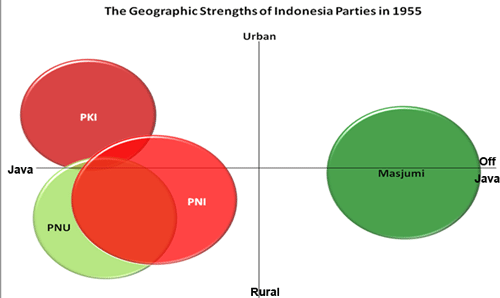There are two key features to this picture. The first is that the number of serious parties has risen from 4 to 7. The second is that the middle ground is now filled with competing parties. This “battle for the middle” is a feature common to any stable polity. When the forces of polarisation are dominant, as we saw in 1955, the potential for significant instability is manifest.
Does this mean the forces opposed to Islamic politics have increased? Yes that is clear. However, it is equally clear that there has also been a decline in the number of those who oppose any role or respect for religious thinking to “invade” the public domain. Indeed both secularists and Islamists have lost support over this time.
The emergent dominant position of this middle ground reflects a position which I characterise as a “State of Godliness”. In terms of a Western comparison, it may be akin to comparing an aggressively secular Western Europe with contemporary USA, where religious piety is a critical credential for electoral success and religious “dogma” is a key electoral dividing line with abortion and stem-cell research typical hot political issues.
Advertisement
Historically in Indonesia the political fault line has been fought over something known as the Jakarta Charter and other attempts to insert an overtly Islamic character in the constitutional structure of the country.
In earlier decades the absence of a political middle ground prevented the emergence of a consensus on managing the issue leading to stalemate and conflict. When the same issue arose in the constitutional reform debates around 2000, the issue was quickly dealt with and compromise reached, with the middle ground parties being able to fashion an acceptable understanding.
More recently we would recall that the most controversial and passionately debated law of the past five years has been about a proposed law to oppose pornography and porno-actions. The Islamic parties have been active proponents of this law, while PDIP has been most aggressively opposed to it. Again the parties in the middle have tended to take the view that may be crudely summarised as “we also oppose pornography but porno-action opens the path for all manner of abuse of state authority”. This debate is still ongoing, but clearly contained with the realm of democratic politics.
Not surprisingly those at the edge of the spectrum nowadays seek to present a more “moderate” face in order to secure their electoral futures. From the right we see both PKS and PPP engaged in rather public debates about not being “exclusivist”, while from the left PDIP has recently established a small Islamic support group to burnish its credentials as not being anti-Islamic.
A third set of divisions in Indonesian partisan politics can be seen in terms of geography, specifically between urban and rural voters and between people on Java and those off Java. The next chart indicates the geographic concentration of support for the major parties in 1955.

Advertisement
Once again we see a considerable empty space along the Java and off-Java axis, with three of the four big parties demonstrating a strong concentration of support on Java while Masjumi’s support was concentrated off Java.
In general, support for secular-nationalist leaning parties off Java was quite modest. Indeed the Protestant party, Parkindo, enjoyed considerably more support off Java than the Communist Party (PKI) while the Catholic Party gained almost as many votes as the PKI. The absence of parties with substantive cross regional support bases was especially devastating considering there was no specific regions’ house in the Legislature. This meant that the demographic dominance of Java was reflected in politics and the national policy agenda, leaving the citizens off Java effectively impotent to affect national policy through constitutional and democratic means.
It is little wonder that, especially considering the strong leftward drift of Java towards the Communist Party seen in the regional elections of 1957, many of the off Java regions ended up in a physical conflict with Jakarta by the end of the 1950s.
Discuss in our Forums
See what other readers are saying about this article!
Click here to read & post comments.
1 post so far.